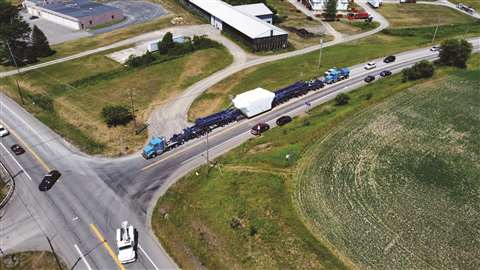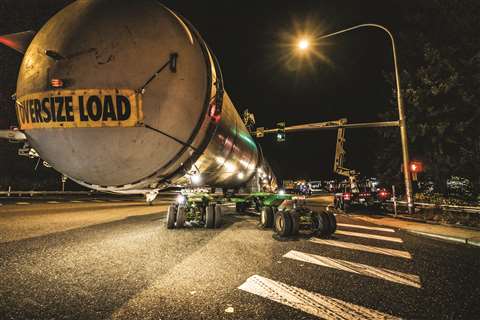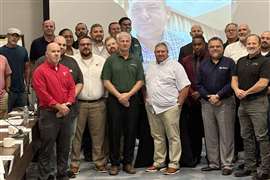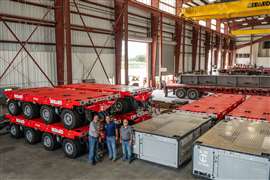How to navigate heavy haul permitting
27 January 2023
Take a closer look at how permitting fits into the successful implementation of a heavy haul project.
To the untrained eye, a heavy haul job may appear as simple as a trip from Point A to Point B. One dot on the map to another. But whether it’s circled, pinned or marked with a star, arriving at your final destination is anything but black and white. Whether a specialized transportation job is 20 miles or 2,000 miles, strategic planning is a key part of every successful heavy haul job.
 Whether a specialized transportation job is 20 miles or 2,000 miles, strategic planning is a key part of a successful heavy haul job.
Whether a specialized transportation job is 20 miles or 2,000 miles, strategic planning is a key part of a successful heavy haul job.
“With Global Positioning System (GPS) mapping systems available on every smartphone, the art of trip planning appears to be fading,” said Rick Malchow, transportation management editor, J. J. Keller & Associates. “While a solid trip plan is a best practice for any driver, it is a critical skill for a heavy haul movement.”
Beyond dealing with the intricacies of the rigging and transport of oversized, overweight cargo, route planning and permitting tasks are essential. Just as you wouldn’t set out on a hike without a map of the trail or try to build a dresser from IKEA without directions, (however painstaking they may be), a heavy haul driver also won’t get behind the wheel without intense planning and a team effort.
“The driver needs to know the states’ travel size and weight limits, overhead clearances, route restrictions, time of day restrictions, highway and bridge weight limits and more,” added Malchow. “A heavy haul movement requires more time to plan and more time to execute than a ‘standard’ move. Special routing software or a good trucking atlas are critical tools.”
Breaking down the pre-trip planning process
Some of Oregon-based Omega Morgan’s industrial services include specialized transportation, heavy lift and rigging and machinery moving. No stranger to the ins and outs of permitting, their process starts long before a project is even awarded.
“Our estimators review the project and develop a plan for execution that allows them to understand manpower and equipment requirements as well as potential routing,” said Erik Zander, chief operating officer, Omega Morgan. “Depending on the complexity of the project they work with, our engineering, permitting and field operations team rely on input. Upon award of a project, this same team assembles and together they formulate the plan and associated tasks that each internal functional unit will need to complete for a successful move. This is spearheaded by a project manager assigned to the project. For us this is where the major group think happens to take what our estimating team started and try to refine and add value.”
It’s safe to say there are plenty of moving parts when it comes to successful heavy haul planning, and communication is a critical component.
“We prefer to talk through any concerns and route preferences before obtaining permits,” said Barry Harrison, president, Custom Permits. “The weight and size of a load must be considered at all points in the process. A fundamental part of permitting is to understand each weight and dimension. A misunderstanding could cost thousands of dollars in fines due to an improper permit.”
At Miller Transfer, a specialty transportation carrier that operates across North America, the teams’ local business development and operations managers work closely with the customer and their internal heavy haul group to ensure that the necessary information is gathered.
“We ask for drawings for all shipments included in a project to ensure that all dimensions and weights are accurate,” said David Cochran, vice president of business marketing and development, Miller Transfer. “We gather the origin and destination information and utilize our historical knowledge to review possible routes and challenges we have faced in the past. We then develop a schedule with the best trailer for the job based on availability and timing.”
 At Omega Morgan, the permit process starts long before a heavy haul project is even awarded. It’s all about planning.
At Omega Morgan, the permit process starts long before a heavy haul project is even awarded. It’s all about planning.
What are the challenges of permitting?
But like any high-level transportation project, there are challenges along the way, and inconsistencies that must be accounted for, especially with differing regulations by city, province, local jurisdiction or state.
“It’s a new set of rules with every state line you hit and every city or county within that state,” said Zander. “There are different requirements for what information is on drawings or how the information is presented, there’s different requirements for trailer registrations, there’s different requirements for processing permits, there’s different requirements for route surveys. Some states/provinces take 30 to 60 days to process a permit while its neighboring state take 3 to 5 days. Routing is constantly changing.”
Another element to consider is that the planning process can either be handled in-house with the heavy haul company, or through permitting companies. Each comes with its own pros and cons and serves as another important pre-trip decision to be made.
“For smaller companies that don’t want to have a full-time permit department it allows them to save on overhead and focus on the move,” said Zander. “Generally, these services have a good understanding of rules in all states and provinces so if you are new to an area, it can save you time and money from making a mistake.”
For more complex configurations, Zander said in-house permitting allows the Omega Morgan team to talk directly with the state and provide direct communications to both the project team and customer, in real time.
Cochran echoed this sentiment, and attributes Miller Transfer’s central permit team to a better turnaround time, and more control of the jobs they are tasked with performing.
“Having focused company representatives help to build trust and relationships with our customers, permit offices and our employees. This approach also puts our driver group at ease, knowing that we are doing it right.”
But as differing needs come into play across North America, third-party companies have narrowed down the necessities of permitting and a successful heavy haul.
“As a permit service provider our process for developing a plan for our customers varies based on the load type and complexity of the project,” said Becky Woods, vice president of operations, WCS Permits & Pilot Cars. “For more complex heavy haul superload moves, WCS has created a detailed list of internal protocols that every superload agent references when assisting in the planning of a complex heavy haul move.”
The basics of permitting
Woods added that the most common issue she encounters is when carriers say they were unaware that a local permit was required, and then their move is delayed due to that jurisdiction requiring additional insurance or bond requirements.
“Although possible challenges can arise at any time in the transportation industry, I firmly believe that a reliable, knowledgeable permit service provider can minimize unnecessary stress and potential delays,” she said.
J. J. Keller’s Malchow broke down the basic requirements of permitting into three critical obstacles to overcome, starting with determining whether a permit is required.
“The second is understanding how to obtain the permit. In many states, an account needs to be created to self-issue a permit online,” said Malchow. “Using a third-party provider to arrange the permit can simplify the task for many states. The third challenge is timing. Some permits may require a review by an engineering team. In addition, permit offices are not necessarily 24/7 operations – plan ahead. Beyond these challenges is determining the flagging, lighting, signing and escort requirements.”
STAY CONNECTED


Receive the information you need when you need it through our world-leading magazines, newsletters and daily briefings.
CONNECT WITH THE TEAM












